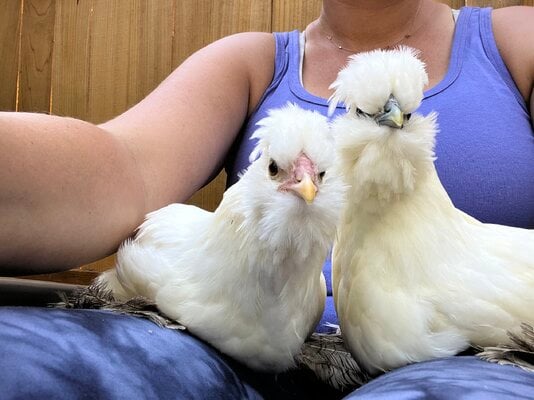Hi all,
I have 4 2-yo hens. I just got 2 3-month old bantam hens (Cochin/silkie mix, pure white, one with red face, one with black face). We keep them separated during the day. At night, the little girls sleep in the coop with the big girls, and all is fine. I had been waking up at 615am each morning to separate the new girls from the old (keep 2 in the extended run/the others in the coop/run or vice versa). Well, I decided to see how it would go if I just let them be in the morning until 8am. The last two mornings, I’ve watched on the video playback, there is a LOT of chasing, pecking, pulling feathers, chasing the new girls into corners, etc. I’m sharing a video clip below to show what it looks like. This is my first time integrating new birds and I don’t know if what I’m seeing is normal. I should note two things: one, I know their water is filthy as it’s from the day before and will get changed as soon as I go out there in the am, and two, the red faced bird seems to be getting the brunt of the abuse.
Our older girls free range in our fenced in backyard around 3-4 hours a day. The coop is 4x4, covered run is 4x8 and extended run is 4x10.
Any advice is welcome! I know there’s normal pecking order determining that needs to happen, but I kind of thought, once the hens establish who’s in charge, they’d be done with it…
Edited to add: there are 3 feed stations, 2 water stations, a low board that only the little girls can fit under, 4 roosting bars in the runs. We’ve had them for 5 days and have kept them separated all the time except for nights and these last two mornings, for 2 hours in the morning (from wake up til about 8am).
Video link here: https://drive.google.com/file/d/1jiMikxh5TBigTI83qF0a3p8luSUh1c0h/view?usp=drivesdk
I have 4 2-yo hens. I just got 2 3-month old bantam hens (Cochin/silkie mix, pure white, one with red face, one with black face). We keep them separated during the day. At night, the little girls sleep in the coop with the big girls, and all is fine. I had been waking up at 615am each morning to separate the new girls from the old (keep 2 in the extended run/the others in the coop/run or vice versa). Well, I decided to see how it would go if I just let them be in the morning until 8am. The last two mornings, I’ve watched on the video playback, there is a LOT of chasing, pecking, pulling feathers, chasing the new girls into corners, etc. I’m sharing a video clip below to show what it looks like. This is my first time integrating new birds and I don’t know if what I’m seeing is normal. I should note two things: one, I know their water is filthy as it’s from the day before and will get changed as soon as I go out there in the am, and two, the red faced bird seems to be getting the brunt of the abuse.
Our older girls free range in our fenced in backyard around 3-4 hours a day. The coop is 4x4, covered run is 4x8 and extended run is 4x10.
Any advice is welcome! I know there’s normal pecking order determining that needs to happen, but I kind of thought, once the hens establish who’s in charge, they’d be done with it…
Edited to add: there are 3 feed stations, 2 water stations, a low board that only the little girls can fit under, 4 roosting bars in the runs. We’ve had them for 5 days and have kept them separated all the time except for nights and these last two mornings, for 2 hours in the morning (from wake up til about 8am).
Video link here: https://drive.google.com/file/d/1jiMikxh5TBigTI83qF0a3p8luSUh1c0h/view?usp=drivesdk




